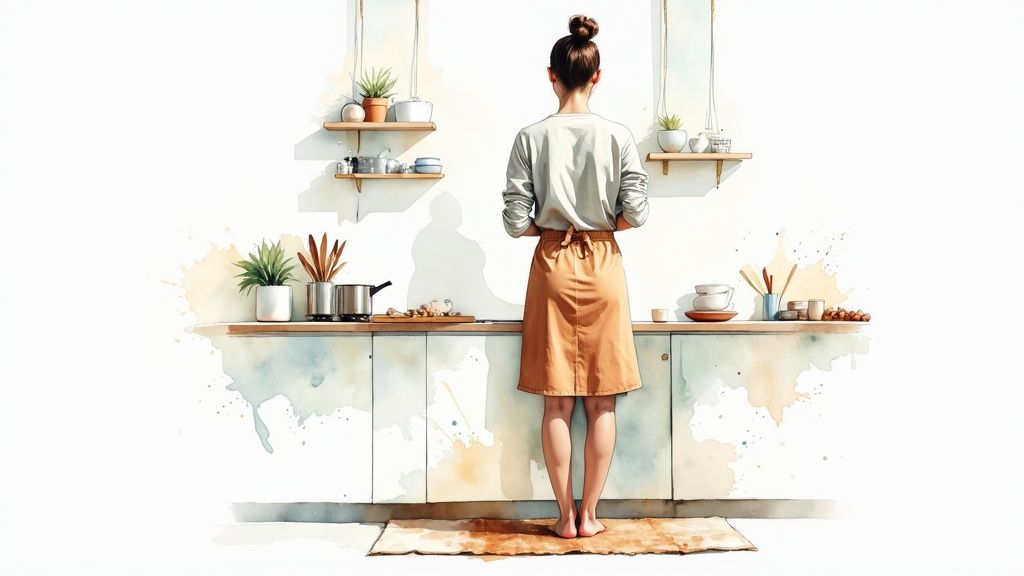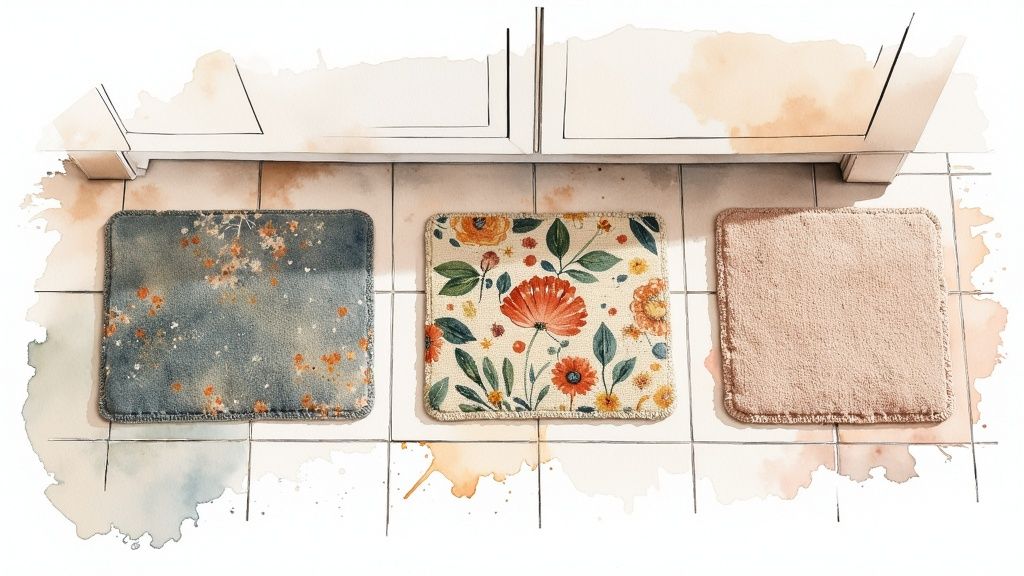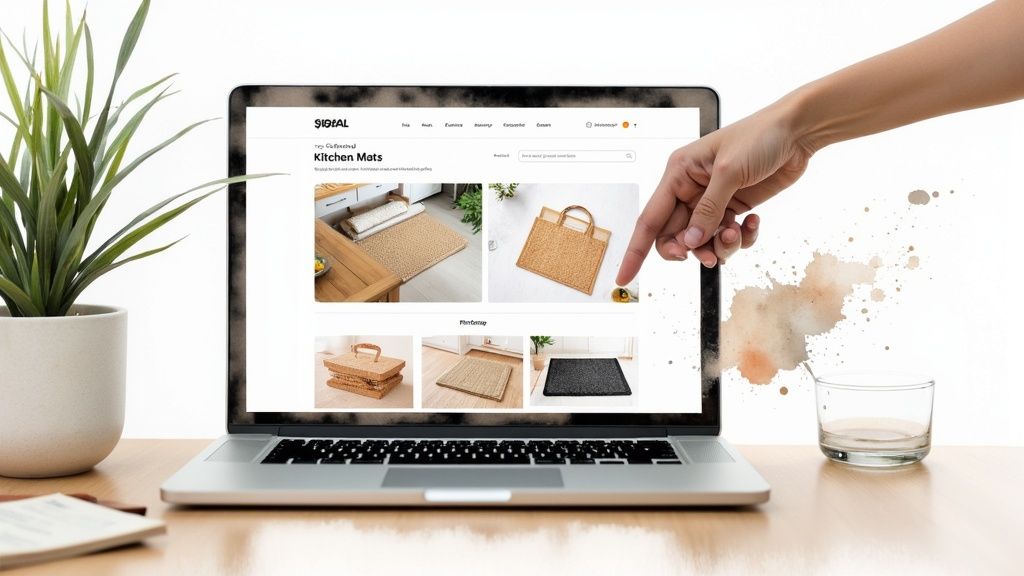A cushioned kitchen floor mat is a practical, ergonomic tool designed to eliminate the strain of standing on hard surfaces for long periods. Its primary function is to provide a soft, supportive surface that absorbs shock, encouraging subtle muscle movements that can dramatically reduce foot, leg, and back pain during and after a long session of cooking or cleaning. This guide provides actionable steps to help you choose, use, and maintain the perfect mat for your needs.
Why Your Kitchen Is Crying Out for an Ergonomic Upgrade
Spending hours in the kitchen on hard tile, unforgiving wood, or laminate floors can feel like a workout you never signed up for. It’s a fast track to sore feet, an aching lower back, and just feeling wiped out. A cushioned kitchen floor mat completely reframes this problem, turning what seems like a simple accessory into a must-have tool for your daily comfort and long-term health.
Think of it this way: you wouldn't run a marathon in dress shoes, right? So why force your body to stand on a rock-hard floor for hours without any real support?
A quality cushioned mat acts like a pair of high-performance sneakers for your kitchen. It absorbs the shock that would otherwise travel straight up your legs and spine, effectively dialing back the physical toll of your daily chores.
This one small change can make a massive difference in how you feel, both right away and over the years.
The Growing Demand for Everyday Comfort and Safety
This shift toward ergonomic thinking isn't just happening in homes. It's part of a much bigger movement we're seeing in commercial and industrial settings. From bustling restaurant kitchens to busy assembly lines, companies have caught on that comfortable workers are safer and more productive.

This growing awareness is lighting a fire under the market. The anti-fatigue mat market, which includes the humble cushioned kitchen floor mat, is on track to explode from US$19.4 billion in 2024 to US$32.1 billion by 2034. North America is poised to grab a huge 24.3% piece of that pie, all thanks to a strong cultural focus on ergonomic health and safety. You can dive deeper into these numbers by checking out detailed market trend reports and driver analyses.
Key Benefits of a Cushioned Kitchen Floor Mat at a Glance
So, what exactly does a cushioned mat do for you? It's not just about feeling a bit cozier. These mats deliver some serious advantages that tackle the real physical stress of standing for long periods. Here's a quick rundown of the immediate and long-term perks.
| Benefit | Impact on You | Where You'll Feel It |
|---|---|---|
| Pain Reduction | Takes the pressure off joints and muscles. | Feet, ankles, knees, and lower back. |
| Improved Circulation | Promotes healthy blood flow through your legs. | Less fatigue and swelling in your legs and feet. |
| Enhanced Safety | Reduces the risk of slips, trips, and falls. | In spill-prone areas like by the sink or stove. |
| Floor Protection | Shields floors from damage. | Prevents scratches, dents, and stains. |
In short, a good mat is an investment in your comfort, safety, and even the longevity of your kitchen floors. It’s a small addition that pays off big time, every single day.
The Science Behind All-Day Kitchen Comfort
Ever spent a long afternoon cooking, only to end the day with aching feet and a sore back? It’s a common complaint, and the culprit is usually the hard floor beneath you. You might wonder how a simple cushioned kitchen floor mat can make such a profound difference, seemingly wiping away hours of discomfort. It’s not magic—it’s just smart ergonomics at work.
A good mat actively pushes back against the physical strain your body takes on when standing on unforgiving surfaces like tile, hardwood, or concrete.
The real secret is something called micro-movements. When you stand on a cushioned mat, its slightly unstable surface forces the muscles in your feet and legs to make tiny, constant adjustments to keep you balanced. You won't even feel it happening, but these subtle contractions are incredibly effective.
Think of these micro-movements as a natural, built-in pump for your circulatory system. They keep your blood flowing properly instead of letting it pool in your lower legs, which is what causes that all-too-familiar feeling of fatigue, swelling, and pain after a marathon baking session.
Shock Absorption for Joint Protection
Beyond keeping your blood moving, a cushioned kitchen mat also serves as a first-class shock absorber for your entire frame. It’s a lot like the suspension system in your car. Just as shock absorbers smooth out a bumpy, jarring ride, the mat’s material works to soften and dissipate the pressure of your body weight with every step.
This creates a protective buffer that shields your joints—from your feet and ankles all the way up to your knees, hips, and lower back—from the relentless impact of standing on a hard floor.
Real-World Example: A bustling downtown bakery was struggling with staff complaining about joint pain and feeling wiped out after long shifts on a concrete floor. After they placed high-quality, 3/4-inch cushioned mats at every workstation, they noticed a significant drop in pain-related issues within a month. The direct benefit was happier employees with more energy, leading to improved morale and productivity.
The Growing Trend of Ergonomic Home Solutions
This idea of building ergonomic support right into our homes is really catching on. The wider market for floor mats was valued at an impressive USD 9.8 billion in 2023 and is expected to climb to USD 15.2 billion by 2032. This surge is largely driven by homeowners who want products that blend great design with real-world health benefits like shock absorption. You can see more details on this trend by exploring the floor mats market and its growth drivers on dataintelo.com.
What this tells us is that people are no longer willing to choose between style and comfort—they want both. Understanding the science behind how these mats work helps you see them not just as a kitchen accessory, but as an essential tool for your well-being. For a closer look at the benefits, don’t miss our guide on what anti-fatigue mats are and the specifics of how they function.
How to Choose the Right Mat Material
When you're looking for the perfect cushioned kitchen mat, not all are created equal. The single biggest difference between a good mat and a truly great one comes down to what it's made of. Think of it like buying tires for your car—the rubber compound determines performance. In the same way, your mat's material dictates its comfort, how long it will last, and how easy it is to keep clean.
This section is your personal guide to the materials world. We'll break down the most common options so you can find the perfect match for your kitchen, your feet, and your lifestyle.
High-Density Foam And Polyurethane
If there’s a gold standard in the world of anti-fatigue mats, it’s high-density foam, especially polyurethane. There’s a good reason for this. Mats made from polyurethane strike an incredible balance between firm, responsive support and serious durability, making them a true workhorse for any busy kitchen.
Unlike softer, cheaper foams that tend to "bottom out" or get permanently squashed over time, polyurethane holds its shape. It continues to provide that same consistent, ergonomic relief year after year.
- Real-World Example: Walk into almost any commercial kitchen, and you’ll find polyurethane mats at the chef stations. They're built to withstand constant foot traffic, resist nasty stains from grease and spills, and provide the all-day support needed for 10-hour shifts. The benefit to the business is fewer worker compensation claims for slip-and-fall incidents and improved staff retention.
Gel And Gel-Infused Foam
If you’re hunting for the absolute peak of plush, cloud-like comfort, a gel mat is probably what you're after. These mats feature a core layer of supportive gel that gently conforms to the unique shape of your feet, creating a sensation that’s hard to beat.
This premium cushioning is a game-changer for anyone dealing with chronic foot pain, arthritis, or plantar fasciitis. While they often carry a higher price tag, the superior pressure relief can be a fantastic investment in your daily well-being. To get a better sense of how these materials work, you can learn more about the connection between anti-fatigue mats and your health.
The core difference is simple: high-density foam provides firm, resilient support ideal for stability, while gel offers softer, contouring comfort that excels at pressure relief.
The chart below gives you a quick visual comparison of how different cushioning materials stack up.

As you can see, a material like natural rubber scores high on durability but might not deliver the same plush comfort you’d get from a gel-infused option.
Cushioned Kitchen Mat Material Comparison
Here's a quick reference table to help you weigh the pros and cons of each material at a glance. Use this to take immediate action on your choice.
| Material | Key Feature | Best For | Average Lifespan |
|---|---|---|---|
| Polyurethane Foam | Firm, resilient support | High-traffic areas & all-day use | 5-8+ years |
| Gel-Infused Foam | Plush, contouring comfort | Maximum pressure & pain relief | 3-5 years |
| Natural/Nitrile Rubber | Extreme durability & grip | Wet areas & industrial-style use | 8-10+ years |
| PVC/Vinyl | Budget-friendly & easy to clean | Light-use areas & tight budgets | 1-3 years |
Choosing the right material really just comes down to knowing what you need it to do.
Rubber And Other Materials
Mats made from natural and nitrile rubber are the undisputed champions of durability and slip resistance. They are incredibly tough, a breeze to clean, and often designed with drainage holes that make them a staple in wet, demanding industrial environments.
For a home kitchen, however, they can sometimes feel a bit too firm or utilitarian. It’s a classic trade-off: you get unmatched ruggedness, but you might sacrifice that plush, forgiving comfort you were looking for.
Ultimately, the best cushioned kitchen floor mat is the one that fits your personal priorities. Are you after long-term durability for a high-traffic family kitchen? Or is maximum pain relief your number one goal? By understanding these material differences, you can pick a mat that perfectly suits your lifestyle, your budget, and your feet.
How to Select the Perfect Cushioned Mat

Choosing the right material is a huge step, but a few other practical details are what separate a good mat from one you’ll genuinely love for years to come. Once you’ve narrowed down the material, it’s time to zoom in on the specifics: thickness, size, and safety. These are the features that really determine how a mat will feel and perform in your actual kitchen.
Getting these details right is how you make sure your investment pays off in both day-to-day comfort and long-term peace of mind.
Find the Sweet Spot for Thickness
The thickness of your cushioned kitchen floor mat is directly tied to how well it works. It's tempting to think that thicker is always better, but there’s a point where too much cushion becomes a problem.
- Too Thin (Under 1/2-inch): These mats tend to "bottom out," meaning your body weight flattens them completely. When that happens, you lose all the anti-fatigue benefits. It’s not much better than standing on a thin rug.
- Too Thick (Over 1-inch): An overly plush mat can feel surprisingly unstable, almost like standing on a wobble board. In a busy kitchen, this can quickly become a serious tripping hazard.
For most people, 3/4-inch is the gold standard. It’s the sweet spot that provides a perfect balance of supportive, cloud-like cushioning and a stable, secure footing. This thickness delivers real ergonomic relief without introducing a new safety risk.
Actionable Takeaway: When shopping, make thickness a key filter. Aim for a 3/4-inch mat as your benchmark for quality, ensuring you get the best of both comfort and stability.
Measure for Optimal Coverage
Even the world's best mat won't do you much good if it's the wrong size. Before you hit "buy," take this simple step: think about your kitchen's "work triangle"—the spots where you spend the most time standing. This is almost always in front of the sink, the stove, and your main prep counter. Grab a tape measure and get the dimensions of these key zones.
Real-World Example: Imagine a family with kids and a dog running around. Instead of a tiny mat by the sink, a longer runner-style mat, perhaps 20 inches wide by 60 inches long, is a better choice. This covers the whole high-traffic path between the sink and stove. The benefit is a continuous cushioned surface that protects more of the floor and eliminates the trip hazard created by multiple small mats.
Prioritize Non-Negotiable Safety Features
In a room where spills, splatters, and quick movements are just part of the routine, safety has to be a top priority. There are two features that are absolutely essential for any cushioned mat you’re considering for your kitchen.
- Beveled Edges: These are edges that are sloped or tapered down to meet the floor. This is a non-negotiable safety feature. It dramatically reduces the chances of catching your toe on the edge of the mat and taking a tumble.
- Non-Slip Surface and Backing: The top of the mat should have a subtle texture to give your feet some grip, even if it gets a little wet. Just as crucial, the bottom must be made from a non-slip material that anchors it firmly to the floor.
The demand for safer, more ergonomic solutions at home is growing fast. The global floor mats market, which includes kitchen mats, was valued at USD 2.28 billion in 2023 and is expected to reach USD 5.81 billion by 2030.
The safety principles for home kitchens are similar to those in professional settings. If you’re curious, we have a guide that covers 8 things to consider when selecting mats for slippery surfaces that offers even more great tips.
A Practical Guide to Mat Maintenance
A quality cushioned kitchen floor mat is an investment in your comfort, and luckily, protecting that investment is simpler than you might think. With just a few good habits, you can keep your mat looking and feeling brand new for years to come.
Proper maintenance isn't just about extending the life of your mat—it's about making sure it remains a clean and safe surface right in the heart of your home.
Most day-to-day messes are no big deal. Spills and splatters are just part of life in a busy kitchen, but for a non-porous mat made of materials like polyurethane or rubber, they wipe right up. Just grab a damp cloth or paper towel and you're done.
For a deeper clean, all you really need is a simple mix of mild dish soap and warm water. This gentle solution cuts through grime without relying on harsh chemicals that could damage the mat's surface over time.
Simple Cleaning Routines for Your Mat
To keep your cushioned kitchen mat in top shape without a lot of effort, it helps to have a simple schedule. Breaking it down into daily and weekly tasks makes maintenance feel like second nature.
- Daily Action: After you’re done cooking, give the mat a quick once-over with a damp cloth. This catches any fresh spills or crumbs and takes less than a minute, stopping grime before it even starts.
- Weekly Action: Once a week, use a soft cloth with your mild soap and water solution for a more thorough cleaning. Just be sure to rinse it with a clean, damp cloth and let it dry completely before putting it back on the floor.
Real-World Example: Imagine a busy home daycare with a large cushioned runner in its kitchenette. To maintain hygiene, the staff implements a simple cleaning protocol: a quick wipe-down after every meal and a full soap-and-water wash every Friday. The benefit of this simple routine is a constantly sanitary and safe surface for both the children and the staff.
How to Prevent Damage and Handle Stubborn Stains
Beyond regular cleaning, a little preventative care goes a long way. The biggest enemies of your mat? Sharp objects and harsh chemicals.
Try to avoid wearing high heels on the mat and be mindful of dropped knives or other sharp utensils to prevent punctures or cuts. If you get a stubborn, sticky mess, resist the urge to scrape at it with a metal tool. Instead, a plastic spatula or even an old credit card can gently lift the gunk without scratching the surface.
For tough stains like oil or wine, act quickly. Blot the spill immediately to soak up as much as possible, then treat the spot with your soap and water mixture. For oily messes, a good dish soap designed to cut through grease works wonders.
And one last tip: always test any new cleaning product on a small, hidden spot first, just to make sure it won’t cause any discoloration. Following these practical steps will protect your mat and help keep your kitchen safe, comfortable, and sanitary for years to come.
Common Questions About Cushioned Kitchen Mats

Even after diving into all the benefits and features, you probably still have a few practical questions. It's only natural. This is where we tackle the most common things people ask when they're about to choose or start using a cushioned kitchen floor mat.
Think of this as the final piece of the puzzle. We’ve gathered the most frequent queries and provided clear, straightforward answers based on real-world experience. Let's clear up any lingering doubts so you can feel completely confident in your decision.
How Thick Should a Cushioned Kitchen Mat Be?
When it comes to thickness, the sweet spot is generally between 1/2-inch and 3/4-inch. This range strikes the perfect balance between soft, forgiving comfort and solid, reliable stability.
If a mat is too thin, your feet will just "bottom out" and press right through to the hard floor, which completely defeats the purpose. On the other hand, a mat that's overly thick—say, more than an inch—can feel wobbly and quickly turn into a tripping hazard, especially when you're moving around a busy kitchen.
For most people, a 3/4-inch thickness is the gold standard. It provides that truly substantial, cloud-like support you want without creating a clumsy, unsafe ledge on your floor.
Can I Use a Yoga Mat or Bathroom Mat Instead?
It’s a tempting thought, but for safety and effectiveness, using a yoga or bathroom mat in the kitchen is a bad idea. They might seem similar, but they are engineered for entirely different jobs.
A yoga mat is designed for grip and temporary padding, not the durable, all-day support needed for standing. A bath mat's main job is to absorb water; it lacks the dense, supportive core and crucial safety features, like beveled edges, that a proper anti-fatigue mat requires.
A proper cushioned kitchen floor mat is built from the ground up with high-density materials designed to combat fatigue. It’s also made to withstand everything a kitchen can throw at it—spills, stains, and constant foot traffic. If you want to get into the science of it, you can learn more about general anti-fatigue mat benefits.
Are These Mats Safe for Hardwood Floors?
Yes, absolutely. The vast majority of high-quality cushioned kitchen mats are designed to be completely safe for all sealed flooring types, including hardwood, luxury vinyl tile (LVT), laminate, and ceramic tile. The trick is to check the manufacturer's notes before you buy.
You’ll want to look for a mat with a non-staining, non-adhesive backing. Some cheaper, low-grade rubber backings can have a chemical reaction with certain floor finishes over time, which can lead to discoloration. Premium mats are made to avoid this.
- Actionable Tip: To ensure maximum floor protection, periodically lift your mat and clean underneath (e.g., once a month). This keeps your floor sparkling and allows it to breathe, preventing any moisture from getting trapped.
Real-World Example: A homeowner who had just installed new oak floors was worried about potential damage. They chose a premium polyurethane mat with a certified non-staining backing. By implementing a simple monthly lift-and-clean routine, they have enjoyed two years of comfort with zero harm to their wood floors, giving them peace of mind.
How Do I Clean an Oily Spill from My Mat?
An oily splatter from the frying pan is almost a kitchen rite of passage. Don't panic—it's easy to clean if you act quickly. Some materials can absorb oil if it's left to sit, so your prompt action is key to preventing a permanent stain.
Here’s a simple, step-by-step process you can implement immediately:
- Blot Immediately: Grab a paper towel or a dry cloth and blot up as much of the oil as you can. Avoid rubbing, as this can push the oil deeper into the mat's surface.
- Apply a Gentle Degreaser: Mix a little warm water with a few drops of mild dish soap. A brand that advertises grease-cutting power is ideal for this task.
- Scrub Gently: Dab a soft cloth or sponge into your soapy solution and gently work on the stain in a circular motion.
- Rinse and Dry: Wipe the area with a clean, damp cloth to remove any soap residue. Ensure the mat is completely dry before placing it back on the floor to prevent slips and protect your flooring.







